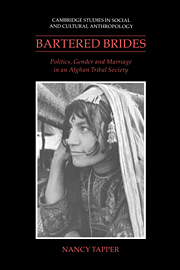Book contents
- Frontmatter
- Contents
- List of illustrations
- List of tables
- List of case studies
- Preface
- Acknowledgements
- Note on transliteration
- List of abbreviations and symbols
- Part I CONTEXTS
- Part II SOCIAL GROUPS AND MARRIAGE
- 4 Patriliny, gender and endogamy
- 5 The Maduzai subtribe
- 6 Household production and reproduction
- Part III IDEOLOGIES OF EQUALITY AND INEQUALITY
- Part IV CASE STUDIES AND STRUCTURAL IMPLICATIONS
- Notes
- References
- Index
- Cambridge Studies in Social and Cultural Anthropology
6 - Household production and reproduction
Published online by Cambridge University Press: 29 August 2009
- Frontmatter
- Contents
- List of illustrations
- List of tables
- List of case studies
- Preface
- Acknowledgements
- Note on transliteration
- List of abbreviations and symbols
- Part I CONTEXTS
- Part II SOCIAL GROUPS AND MARRIAGE
- 4 Patriliny, gender and endogamy
- 5 The Maduzai subtribe
- 6 Household production and reproduction
- Part III IDEOLOGIES OF EQUALITY AND INEQUALITY
- Part IV CASE STUDIES AND STRUCTURAL IMPLICATIONS
- Notes
- References
- Index
- Cambridge Studies in Social and Cultural Anthropology
Summary
One aim of this chapter is to outline the economic background of Maduzai marriage. The annual productive cycle, the character and amounts of capital resources controlled by households of the subtribe, and employment within the subtribe, will all be discussed, but the principal focus of this chapter is the relationship between marriage and household structure. The two are intrinsically linked, and the ‘household’ might also be defined as all those people who accept the decisions of the household head with regard to their marriages and those of their children and who allow the head to manage the raising of a brideprice or the disposal of a brideprice received. However, since household heads may not face such decisions for years or indeed at all during the period of their leadership, such a criterion is not sufficient for definitional purposes. Nonetheless, decisions about marriage remain the most important opportunity for household members to test the head's continuing dominance, and such decisions frequently become a pretext for household division, while the character of relationships between married members of a single household is viewed by Durrani as the ultimate determinant of household continuity or dispersal. Other factors are also relevant to a discussion of the developmental cycle of Durrani households, especially the number of marriages to be managed and their sequence, in terms of both the intervals between them and the sex of the principals.
- Type
- Chapter
- Information
- Bartered BridesPolitics, Gender and Marriage in an Afghan Tribal Society, pp. 101 - 138Publisher: Cambridge University PressPrint publication year: 1991



